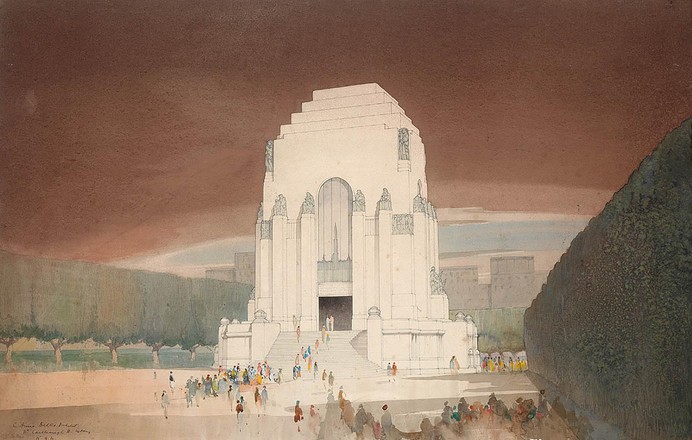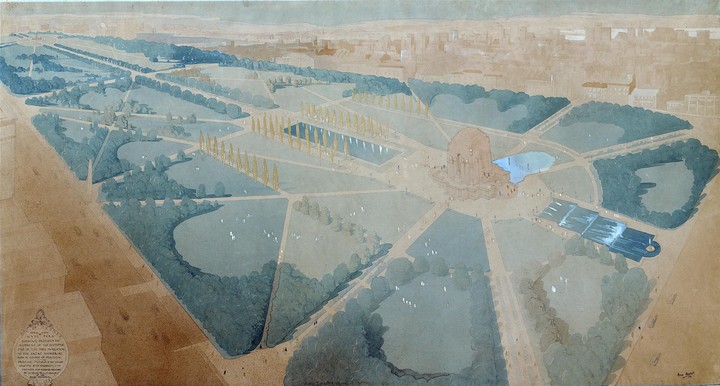Raynor Hoff
By http://www.anzacmemorial.nsw.gov.au
The sculpture which forms such an important
element in the design of the Anzac Memorial is the work of Rayner Hoff.
Born in 1894, Hoff studied drawing and basic
design at the Nottingham School of Arts and learned the basic skills of
sculpture in his father's masonry yard. He served in the army in the Great War
including a year in the trenches in France.
After the war he continued his studies in London
and Italy and in 1923 came to Australia to take up a position as instructor in
drawing and sculpture at Sydney Technical College.
In 1930 Bruce Dellit asked Hoff to create the
sculptures for the Memorial. 'It did not take long for me to realise that in
Hoff, Australia had acquired an artist of outstanding qualities', Dellit wrote
after Hoff's tragically early death in 1937. As an artist, Hoff had qualities
of greatness evidenced in his ability to portray the dramatic.
His concept forcefully included the commemoration
of women at war, both in their personal loss and in their contribution to the
war effort.
Hoff's other major public works included Governor
Philip in the Manly Hotel, The National War Memorial, Adelaide, and the King
George V Memorial, Canberra.
Stars of Memory
By http://www.anzacmemorial.nsw.gov.au
The dome of the Hall of Memory rises to a height
of 26 metres. The 120 000 golden stars covering the ceiling honour the men and
women from New South Wales who enlisted for service in First World War. From
this number, 21 000 were killed, or died later from their wounds, and 50 000
were wounded. Many others were left with the after effects of war, including
mental scarring.
When the Anzac Memorial was constructed between
1932 and 1934 there was a shortage of funds due to the effects of the Great
Depression. In order to complete the building, the Trustees accepted a proposal
that members of the public could contribute by purchasing a star for two
shillings (20 cents) each. While not all of the stars were sold, sufficient
funds were raised to enable the completion of the Memorial. The stars are made
from plaster covered with gold paint and glued into position. It is not known
why the density of the stars increases towards the top of the dome.
Other Dellit plans in the Library's collection
There
are other plans by Bruce Dellit in the Library’s collection, including Anzac Memorial competition, sectional
perspective, 1930 and Aerial view of
Hyde Park … in relation to the Anzac Memorial now in course of erection, July 1932.
They are located at ML 195 and DG 441 respectively.
Dellit’s projects and training
By Design & Art Australia Online
Dellit trained under Byera Hadley at Sydney
Technical College and Leslie Wilkinson at the University of Sydney. He was chief
draftsman on the Brisbane City Hall project in the 1920s. While in Brisbane he
worked on a number of landscape paintings, one of which, In Roma Street (watercolour,
1921), was acquired by the then National Art Gallery of New South Wales in
1922.
Dellit’s buildings include Kyle House and the
Anzac Memorial in Sydney. He also designed the art deco interiors of the
Kinsella funeral chapel (later used as a famous Sydney nightclub) and the Hotel
Australia’s ballroom. His own house in Wahroonga was of a more modest,
Spanish-influenced design.
Anzac Memorial, Hyde Park
By Dictionary of Sydney
This
is the main war memorial in Sydney and one of the city's finest Art Deco
buildings. It embodies the collective grief of the people of NSW at the loss of
Australian servicemen and women since World War I. It is associated with the
landing of Australian troops at Gallipoli on 25 April 1915, since fundraising
for the memorial was established on the first anniversary of the landing.
C Bruce Dellit
By The Royal Australian Institute of Architects (NSW Chapter)
Charles Bruce Dellit was born in Sydney and was
educated at the Sydney Technical College under Byera Hadley and at Sydney
University under Professor Wilkinson.
One of his earliest jobs was acting in the
capacity of Chief Draftsman on the design of the Brisbane Town Hall.
On his return to Sydney, he entered into
partnership with the old established firm of Spain & Cosh with whom he
designed the building of Marcus Clark & Co Ltd, Scottish House and Evening
News Building in Sydney and Dalgely's in Newcastle.
In 1929, he commenced practice privately
designing Australia House, Kyle House, the Australia Hotel Ballroom and Dining
Room, Sydney's Liberty Theatre, the Kinsella Chapels in Darlinghurst, Messrs
Howes & Howes store and the Anzac Memorial in Hyde Park. Delfin House, O'Connell
Street was his last major work prior to his premature death in 1942.
Works:
Kyle House, 27–31 Macquarie Place, 1931
Anzac War Memorial, Hyde Park, 1934
Anzac Memorial – external sculptures
By http://www.anzacmemorial.nsw.gov.au
Dellit originally planned for numerous bronze sculptures to adorn the
exterior of the Memorial. He planned for a standing figure on each of the
corners, the 'Four Seasons' and sixteen seated figures, four to a side,
representing 'the Arts of Peace and War'. Hoff transformed these classicized or
allegorical figures to unmistakable Australian figures from the Great
War – modern Anzacs in modern military dress, in stylised in modern
form – which emphatically locate the Memorial in the Australian present. Their
original bronze castings were changed to cast granite (ground granite packed
into moulds), so that they would seem to be hewn from the building itself, or
flowering from the buttresses, in Dellit's own words. The figures, heroic in
size and broadly sculptured in sympathy with the character of the architecture,
are shown with bowed heads, as if resting after their labours and sadly
contemplating the havoc of the war years.



 Back to list
Back to list